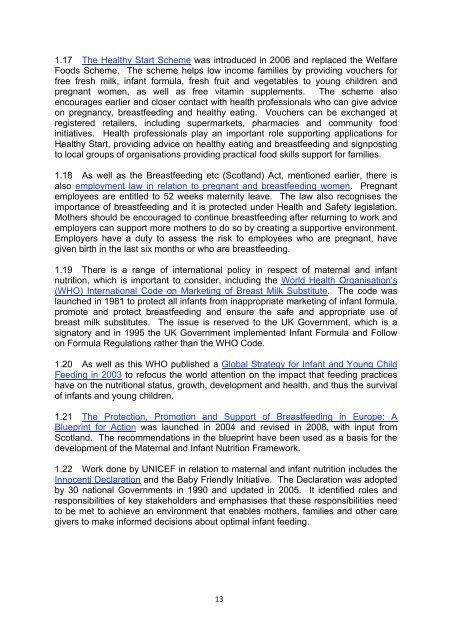Improving Maternal and Infant Nutrition: A Framework for Action
Improving Maternal and Infant Nutrition: A Framework for Action
Improving Maternal and Infant Nutrition: A Framework for Action
You also want an ePaper? Increase the reach of your titles
YUMPU automatically turns print PDFs into web optimized ePapers that Google loves.
1.17 The Healthy Start Scheme was introduced in 2006 <strong>and</strong> replaced the WelfareFoods Scheme. The scheme helps low income families by providing vouchers <strong>for</strong>free fresh milk, infant <strong>for</strong>mula, fresh fruit <strong>and</strong> vegetables to young children <strong>and</strong>pregnant women, as well as free vitamin supplements. The scheme alsoencourages earlier <strong>and</strong> closer contact with health professionals who can give adviceon pregnancy, breastfeeding <strong>and</strong> healthy eating. Vouchers can be exchanged atregistered retailers, including supermarkets, pharmacies <strong>and</strong> community foodinitiatives. Health professionals play an important role supporting applications <strong>for</strong>Healthy Start, providing advice on healthy eating <strong>and</strong> breastfeeding <strong>and</strong> signpostingto local groups of organisations providing practical food skills support <strong>for</strong> families.1.18 As well as the Breastfeeding etc (Scotl<strong>and</strong>) Act, mentioned earlier, there isalso employment law in relation to pregnant <strong>and</strong> breastfeeding women. Pregnantemployees are entitled to 52 weeks maternity leave. The law also recognises theimportance of breastfeeding <strong>and</strong> it is protected under Health <strong>and</strong> Safety legislation.Mothers should be encouraged to continue breastfeeding after returning to work <strong>and</strong>employers can support more mothers to do so by creating a supportive environment.Employers have a duty to assess the risk to employees who are pregnant, havegiven birth in the last six months or who are breastfeeding.1.19 There is a range of international policy in respect of maternal <strong>and</strong> infantnutrition, which is important to consider, including the World Health Organisation’s(WHO) International Code on Marketing of Breast Milk Substitute. The code waslaunched in 1981 to protect all infants from inappropriate marketing of infant <strong>for</strong>mula,promote <strong>and</strong> protect breastfeeding <strong>and</strong> ensure the safe <strong>and</strong> appropriate use ofbreast milk substitutes. The issue is reserved to the UK Government, which is asignatory <strong>and</strong> in 1995 the UK Government implemented <strong>Infant</strong> Formula <strong>and</strong> Followon Formula Regulations rather than the WHO Code.1.20 As well as this WHO published a Global Strategy <strong>for</strong> <strong>Infant</strong> <strong>and</strong> Young ChildFeeding in 2003 to refocus the world attention on the impact that feeding practiceshave on the nutritional status, growth, development <strong>and</strong> health, <strong>and</strong> thus the survivalof infants <strong>and</strong> young children.1.21 The Protection, Promotion <strong>and</strong> Support of Breastfeeding in Europe: ABlueprint <strong>for</strong> <strong>Action</strong> was launched in 2004 <strong>and</strong> revised in 2008, with input fromScotl<strong>and</strong>. The recommendations in the blueprint have been used as a basis <strong>for</strong> thedevelopment of the <strong>Maternal</strong> <strong>and</strong> <strong>Infant</strong> <strong>Nutrition</strong> <strong>Framework</strong>.1.22 Work done by UNICEF in relation to maternal <strong>and</strong> infant nutrition includes theInnocenti Declaration <strong>and</strong> the Baby Friendly Initiative. The Declaration was adoptedby 30 national Governments in 1990 <strong>and</strong> updated in 2005. It identified roles <strong>and</strong>responsibilities of key stakeholders <strong>and</strong> emphasises that these responsibilities needto be met to achieve an environment that enables mothers, families <strong>and</strong> other caregivers to make in<strong>for</strong>med decisions about optimal infant feeding.
















